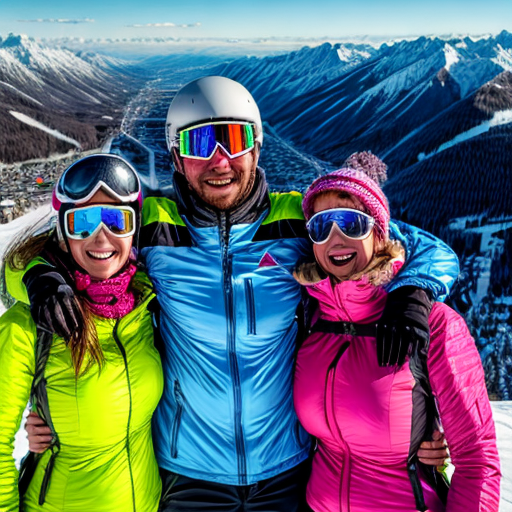
Click. A privacy policy like this is accepted in no time at all. Click. And the computer already knows: about you, about me, about everything. Better than your best friends. Even better than you. Even about Innsbruck? I recently wanted to find out who this computer actually is, what it knows and whether you can believe it. Click here. Look here: the University of Innsbruck is even conducting research on the subject. And click, lo and behold: Sixty at the SoWi even serves really good coffee! And not far away, a young almost-woman doctor who even knows the computer personally, so to speak. Below: My first date with ChatGPT, a dancing robot and a very serious affair.
The magistra and the machine
Magistra Viviana Oberhofer in the ivory tower of SoWi Innsbruck.
I immediately take Sam, the little humanoid robot, to my heart.
Viviana Oberhofer doesn't look like you might imagine at first. Cheerful, dynamic and highly motivated - somehow I had computer freaks written all over my memory. And yet: Viviana is researching social robots and chatbots at the University of Innsbruck. Over our first coffee, I hold her own CV, written by ChatGPT, under her nose. Well, smiles the PHD student, even the digital devil is clearly in the details (here is the real CV). It almost reads perfectly, but if you look closely, there are hidden errors and made-up facts. And there are good reasons for this, grins the computer scientist, but all in a row. I accompany her to her workplace in the ivory tower. "Institute for Information Systems, Production Management & Logistics" is written at the beginning, I yawn reflexively and immediately choke on a childish cry of joy: there is a small, humanoid robot at her desk. Hi Sam, says Viviana and sits down.
Human for beginners
The Magistra and the machine.
How humanity works with robots.
Viviana makes me understand the complex relationships.
This is what the matrix looks like in the background of a chatbot.
And this is what research looks like.
The Greek thinker Xenophanes once defined two types of antropomorphism (human likeness): Appearance and behavior. In order for us to perceive certain models as human-like, at least one of these parameters must be adequately addressed, Viviana explains to me. With nimble fingers, she edits the input line of her computer console and Sam (she/her) comes to life: The cameras and sensors register me, Sam turns her head towards me and asks how I am (we speak English). A little anxious, I confess uncertainly and Sam kindly but firmly recommends that I see a doctor. When I ask Sam if she would like to accompany me, Sam shakes her head sadly - she still doesn't have the right software to go for a walk. In principle, a rule-based system works very similarly to Alexa, the scientist explains to me: Fixed question, fixed answer. A simple if-then game with predefined code parameters. Fingers fly again and Sam dances for us. As the last line of code flickers across the screen, Sam quietly hums back to neutral, then the light in her eyes goes out.
Free question, free answer
But as soon as "thinking" becomes freer, things become much more complex. This is precisely where Viviana is currently conducting research into highly complex AI chatbots, such as ChatGPT, at the direct point of contact between humans and algorithms. Large language models (LLMs), huge databases with billions of parameters, work in the background. The algorithm is then trained to link these parameters as sensibly as possible and make predictions. Probability theory - it brings back memories of school. Exactly, smiles the scientist, calculated for every single word of an AI answer.
Child with Kiachl at the Christmas market.
A happy couple skiing on the Nordkette.
The romantic Christmas market in Innsbruck's old town.
The Swarovski Crystal Worlds in Wattens.
The Lumagica light park in the courtyard garden.
A winter vacation picture of the small Alpine town.
Have you noticed that we're already talking about chatbots like people? With "he" or "she", Viviana notes. And that's exactly what Xenophanes meant back then: Sam acts and moves like a human, whereas an AI is supposed to simulate our thinking. The more human/truthful her (!) answers appear, the more we tend to trust her (!). Click. So: What do we ask the AI?
Correct question, correct answer
"Prompt engineering", i.e. the correct entries in the chat line, is a real million-dollar business right now, explains Viviana. To generate an accurate answer, the AI actually only needs two things - a data set and a question. However, because the algorithm is constantly changing and evolving (currently ChatGPT 3.5), the question (prompt) has to be asked as correctly as possible to get the best possible answer. And Viviana types: "List five (note: format) special (quality) winter insider tips (time) for outdoor and culture lovers (target group) in and around Innsbruck (location) and describe in detail why they are so special (reason)." And the chatbot sends us through Tyrol: Bergisel Ski Jump & Museum, then Grawa Waterfalls in the Stubai Valley, then Bergisel Panorama Trail again, then the Nativity Scene Museum in Tulfes and finally through the old town of Hall. Not bad in principle, but the routes are long. Also: no crispy, delicious Kiachl at the Christmas market in the old town, no skiing fun on the Nordkette next door, no Lumagica light magic in the snow-covered Hofgarten and no visit to the Crystal Worlds in Wattens?
Let's try it with more money, this time for the very rich please: private hut dinner, night walk in the Karwendel, private concert at Ambras Castle, balloon ride over the Inn Valley and guided mountain lake hike. Just a few brief comments from the author: you eat better in the valley, nobody really loses anything in the nature park at night, the acoustics in the Haus der Musik are better, you should love icy frosty winds in a balloon and you can go ice swimming in Innsbruck's Baggersee without a mountain guide. You can just tell that ChatGPT is not "from there" and yet simply pretends to be. That's pretty cheeky. So what does Viviana use ChatGPT for herself? For example, the bot revises new exam questions for students or helps with programming. In addition to "human" language models, ChatGPT also speaks programming languages, grins the Magistra. (You can read our prompts here, here and here )
The uncanny valley
You have to tell it like it is: Viviana knows her way around chatbots really well. And I, for my part, know all about texts and recommendations around Innsbruck. At the end of the day, we both agree: you can have a nice chat with a chatbot, but you shouldn't take it (!) too seriously. At the bottom of the chat window, the bot even says this about itself: You shouldn't rely on anything without a thorough fact check. To make this very serious matter even more tangible, we let Bild-KIs invent some snapshots of Innsbruck for this article.
The Uncanny Valley effect: uncomfortable to watch.
Reality through the eyes of an algorithm.
Ambras Castle merges with Wilten Abbey.
The Kiachl from Dengg as an AI recommendation.
Almost right - but not quite.
And again, the unease only creeps in on closer inspection: There's something wrong, isn't there? And that's right: the so-called "uncanny valley" describes an "acceptance gap" in anthropomorphism that exposes an (un)human model as such. We still notice the deception, smiles the magistra, but for how much longer? In the case of Innsbruck, it is better to continue to trust the recommendations of the real locals, see for yourself and enjoy the beauty of the small Alpine town in true-to-life authenticity. If necessary, you can even find eerie valleys here without an algorithm. Click here.
Photos: The pictures of Viviana Oberhofer, Sam and the Ivory Tower were taken by the author. All others were generated by Adobe AI, Adobe Firefly, Midjourney and ChatGPT.
Rate this article
Show me the location on the map
A small "scribbler" with huge passions. Born, raised and refined in Tyrol. Loves to read and can cook almost as well as his grandma. At his happiest when out and about and searching for new horizons.
Similar articles
The mountains around Innsbruck are not only known for their breathtaking beauty, but also for their living…
Beautiful and good: the noble product world Anyone in Tyrol looking for high-quality regional products in attractive…
What do you do when the highest elevation near your home town is only around 150 meters?…
"If the bee disappears from the earth, humans will only have four years to live. No more…























